As we enter 2024, emerging visual technologies such as Augmented Reality (AR), Virtual Reality (VR), 3D Modeling and Try-on are moving more towards the forefront of consumer conversations. For C-suite executives, these innovations are not only shifting the operational framework; they are redefining customer experience and offering new opportunities of interaction and engagement. The introduction of devices such as the Apple Vision Pro headset signifies a turning point - where these technologies move beyond niche applications to become components of everyday consumer life. For business leaders, this shift presents an opportunity to harness these technologies for improved demand forecasting, better personalization, and a profoundly enhanced customer journey.
#1: Apple Vision Pro and beyond, the mainstream validation of AR and VR
The positive market response to new devices like the Apple Vision Pro is a testament to the growing public interest around AR and VR technology. With this technology becoming more applicable to everyday consumers, we are seeing a variety of brands, app makers and retailers see emerging technology as a way to reach more customers. Two examples are BMW’s 2023 initiatives with Meta that explored how AR and VR tech can work inside a fast-moving vehicle and Coach’s AR-powered, highly-realistic try-on mirrors in stores.
Enhanced product visualization through these technologies allows users to interact with products in a virtual space, offering a level of detail and engagement that was previously not available. This helps consumers make more informed decisions, reducing the gap between expectation and reality. It also empowers companies to learn more about customers, their behaviors and how to better forecast their needs.
#2: Improving customer expectations through virtual experiences
During peak seasons, such as the holidays, brands grapple with the considerable challenge of managing high volumes of returns, impacting both their financial standing and contributing to inefficiencies and environmental waste. Nevertheless, the advent of AR, VR, and 3D Modeling introduces a transformative solution. These technologies empower consumers to immerse themselves in product experiences virtually before making a purchase decision, mitigating the risk of disparate expectations and subsequent returns. Beyond financial savings, this paradigm shift yields a more streamlined allocation of staff resources and a reduction in waste, fostering sustainable business practices.
Furthermore, harnessing the power of a 3D catalog and embracing the 3D revolution offers additional advantages, particularly for brands with extensive product catalogs containing hundreds or even thousands of items. This approach not only helps reduce return rates but also eliminates the requirement for expensive samples and photoshoots. Retailers can seamlessly display their entire range of products in a digital environment, showcasing numerous variants without the need for physical samples and avoiding the burden of excess inventory. Such a comprehensive strategy enhances efficiency and fosters a more sustainable and cost-effective business model.
#3: Looking ahead, a future of personalization
In today's fiercely competitive market, waiting for everyone to adopt emerging technologies is a missed opportunity. To truly stand out, we must embrace these technologies ahead of the curve. The 3D modeling industry, projected to exceed 11 billion dollars by 2026 according to data from Statista, highlights the urgency. C-suite executives now have a distinct chance to incorporate these cutting-edge technologies not as futuristic concepts but as immediate and creative opportunities. Seizing this opportunity today sets us apart, allowing us to provide customers with superior experiences, positioning ourselves ahead of the competition in this dynamic landscape.
At the core of these advancements is the drive to deliver thoughtful, personalized customer experiences. The ability to offer real-time customization and immersive product interactions has sparked a new era of user and customer experience. For C-suite executives, being able to deliver this level of personalization not only fosters stronger relationships, but also increases brand loyalty and helps businesses stay ahead of the curve with rapidly changing customer experiences and market demands.






















